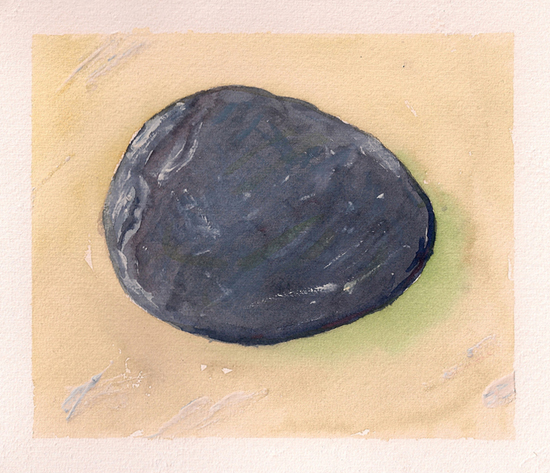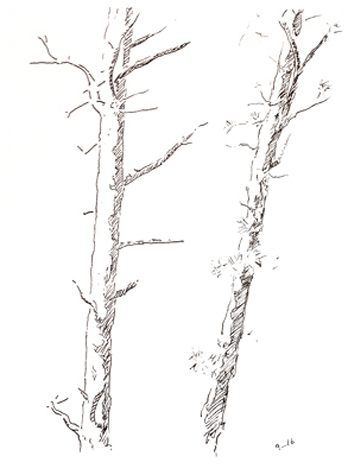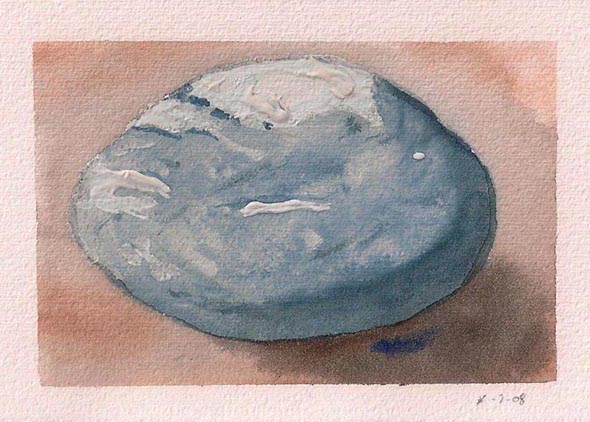Sticks & Stones
Daniel Barbiero
May 2017
 Stone, image courtesy of artist
Stone, image courtesy of artist
Sticks & Stones in the Time of Objects
One sometimes hears of artists whose depictions of things, visually or verbally, penetrate to their supposed inner lives and capture the imagined psychology of these inanimate objects. As if the surfaces weren’t enough or were somehow defective or otherwise an embarrassment of inarticulate immobility. But to a significant extent things—natural things, things as they are before we integrate them into our practical, affective or aesthetic lives—are their surfaces.
In his drawings and paintings of sticks and stones, Brian Olewnick intuits the depth that resides on the surfaces of these natural objects.
Portraits of Things as They Are for Themselves
An image that recurs is of a stone, vaguely ovoid in shape. Its contours are softly rounded, its topography consists of gently undulating swells and niches hinted at by impastoed paint or a contrast of color. Its size is difficult to determine, as it is portrayed by itself in an otherwise empty, circumscribed space. There is nothing to compare it to, nothing to establish its scale. It stands at the center, pushing up against the borders of the picture plane. The relationship of its mass to the surrounding space is negated qua relationship; its mass seems to absorb space, drawing it in and extinguishing it as an independent variable. There is the stone, its edge, and then nothing: A portrait of the thing as it is for itself.
Like Giorgio Morandi, who repeatedly painted arrangements of the same closed set of objects—bottles, jars, pitchers, and other ostensibly mundane items—Olewnick often selects his subjects from the a closed universe of things. For example, the same stone appears and reappears, seen from the same, flat-on perspective. Olewnick notes his tendency to “work small, often using the same objects I’ve kept around and grown attached to for decades.”* Such a long-term acquaintance would seem to foster a capacity for surprise and a way for vision to renew itself rather than to succumb to a numbing familiarity. For all the invariance of perspective, Olewnick reveals different facets of the stone’s surface through subtle changes in color and shading. Again like Morandi, he seems to show us different sides of the same object by showing us the same side in what I’m tempted to think of as its different moods.
These depictions of sticks and stones are portraits of things as we imagine they look when we aren’t there to see them: Mute, full, impervious to the concerns and praxes that fall outside of them even when they are made use of. For this reason we can distinguish these paintings and drawings from still lives. The organization of the still life shows the trace of the human hand which arranges things, creates a synthetic space of inanimate objects externally related to each other by virtue of that hand. And then absents itself. But its trace is still there, in the facts of abutment, adjacency, grouping and so forth—in short, in the frozen dynamic of a space organized from outside. In these images, by contrast, the hand never appears to have been there; the objects in question are juxtaposed rather than organized per se.
 Two Pines Sketch 25, image courtesy of artist
Two Pines Sketch 25, image courtesy of artist
Consider Two Pines, a sketch of two pine trunks. Two thin pine trunks, drawn in a closely observed, realistic manner, float juxtaposed in an undefined, neutral space. The apparent disconnection between the two trunks reflects a deliberate pictorial decision on the part of the artist: The drawing is one of a 2009 series in which Olewnick explored his interest in portraying what he described as “two discrete objects…in separate but shared space.” In this context of seeming non-context, each is the only point of reference of the other.
These trunks aren’t depicted as they would be in nature—there’s no surrounding forest, buildings, field, or any other natural or artificial landmarks in relation to them—but instead are excerpted from nature, which is to say abstracted from the forest or treeline in which they were situated and then held up to view.
Paradoxically, although the two tree trunks have been isolated as objects to be viewed, their depiction effaces the trace of the eye that selected them and the hand that drew them. They appear simply as objects, adjacent to each other but otherwise not connected or brought into any relationship beyond adjacency. It’s in the way that they’ve been drawn: They are just two pine trunks, and nothing more.
In this matter-of-fact depiction of the two trunks there would seem to be no unseen third—no observer to discover and unify the trunks into a synthetic field made whole by the observer’s presence and the act of observation. Observation is the in-relation-to on the basis of which such a synthesis could be effected—a purpose transcending the brute facts of the objects present and uniting them in a field defined by that purpose.
In sum, these sticks and stones, bluntly thrusting themselves into our field of vision, seem to exist in a state that predates our having imposed an order on them. In seeing them this way we seem to move backward from the phenomenon—the thing as it appears to us—to something prior to that. Call it whatever remainder is left over once the phenomenal is subtracted. Once we are subtracted.
We may think that things are a kind of Potemkin village of dubious substance, withdrawing from us once we turn away from them. But this is to negate them needlessly. If we are somehow to encounter them in their inertia, in their thick atemporality we first must go beyond them—imagine them as something else, to grasp them as equipment, ornament or obstacle, or to read them as signs, as I believe we do here. Signs of our absence.
It’s a seeming contradiction that this apparent encounter with the thing as it exists for itself comes to us by virtue of a representation of the thing—an artifact made of an appearance. I suppose this is an acknowledgement of the phenomenal as a closed loop more than anything else, and conversely as a concession to a way of being that, while foreign to us, surrounds us and yet must be approached through a kind of negation—negation of the brute fact through the imagination. Which in essence is what these, or any other representations of the mute natural thing, must be. Thus these paintings create an illusion, the illusion of an encounter with Being in its mute fullness.
The Time of Objects
The Being of a stone is atemporal. How can this be? We see this same stone, softly contoured, its shape quite clearly rounded by the effects of erosion. The stone’s surface shows the effects of time. But for the stone, the future comes to it from outside; its relationship to time is a purely external one.
Time etches itself across the face of the stone with a slow hand. The smooth surfaces give evidence of the resistance of the elements to the stone’s inert material. An irony: This ordinarily immobile object is worn to an aerodynamically efficient shape conducive to swift motion.
The objects we find in the natural world—sticks, stones and the like—are a plenitude because they lack nothing. Because they lack nothing they are atemporal—they don’t project themselves into a future in which they make good on something they lack. They are all presence, all in the present to that extent. They are nonetheless subject to time—they undergo erosion, decay and dissolution—but time comes to them, they do not bring time into the world by projecting a future for themselves.
Without an open future, in a sense everything is already decided. For these sticks and stones and other objects like them. True, one doesn’t know exactly where or how the stone will end up—washed into a gully by a downpour, skipped over the surface of a pond by a curious or bored child, picked up and added to a collection of other stones in an artist’s studio. But in all of these instances everything is decided for the stone, and here the passive voice is entirely appropriate for describing the situation of an object for which its future comes to it from outside.
Because objects’ temporality is external to them—is something that acts upon them—we describe it in the passive voice. The effects of time are etched across their surfaces; they are subject to temporality as reflected in their slow decomposition. Time is something that happens to them. Inevitably when we speak of them we speak for them, and drawing here counts as a form of speaking; in speaking for these things, as the title of one of Francis Ponge’s books would have it, we take the side of objects.
 Stone, image courtesy of artist
Stone, image courtesy of artist
* Quotes are taken from an interview with the artist that appeared on the CatRutgers4artwebsite
https://catrutgers4art.com/2011/05/30/guest-spot-brian-olewnick/
